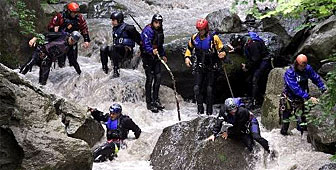
Canyoning trial to open in Interlaken

The long-awaited trial of eight defendants in a 1999 Swiss canyoning accident that killed 21 people begins on Monday in Interlaken.
Eight former managers and canyoning guides of the now defunct company, Adventure World, are accused of manslaughter through culpable negligence.
They face fines or sentences of up to one year, the highest sentence the regional court can hand out. A verdict is expected on December 11.
A lawyer is also representing one of the families of the victims in a private civil suit.
Because of the huge public interest — about 200 journalists, members of the victims’ families and the public are expected to attend — the trial is being held in the ballroom of an Interlaken conference centre, the Casino-Kursaal.
The 21 victims between the ages of 19 and 32 were part of a group swept away by a flash flood in the Saxet Brook outside Interlaken on July 27, 1999. It was the largest accident involving extreme sports, and it shook Switzerland’s image as safety conscious.
Attention in Australia
The trial is expected to receive a lot of media attention in Australia, since 14 of the 21 victims were Australian.
However at a press conference on the eve of the trial the English-speaking media learned that there would be no simultaneous translation or even a summary in English at the end of each day’s proceedings.
The Australian government at the time described the death of so many Australians in one accident as probably “the greatest single peacetime loss of young Australians outside their own country.”
Two Swiss, two South Africans, one Briton and two New Zealanders were the other dead.
The eight defendants are charged with ignoring storm warnings, failing to have worked out a set of safety provisions and providing inadequate supervision and guide training.
The prosecution alleges that the Adventure World guides went ahead with the trip even though a storm had broken over the area. Prosecutors said it could be seen from the starting point of the canyoning expedition, and the guides were not properly instructed “concerning the dangers that can result from a thunderstorm”.
Safety not priority
Experts and industry insiders criticised the business practices of the managers of Adventure World for not making safety a priority.
They said not only did Adventure World employ inexperienced guides, but they also put them under unfair pressure to go ahead with expeditions, despite the conditions, since they were paid according to the number of trips carried out.
Adventure World rejected the criticism, countering that all its guides were fully trained, and that before the accident, the company boasted an excellent safety record, having led 36,000 tourists through the Saxet Brook. It also said the flash flood could not have been foreseen.
A memorial stone to the victims was erected on the banks of the Saxet Brook a few months after the tragedy. But pleas from the families of the victims to ban further canyoning trips from the Saxet Brook were ignored. It reopened for expeditions the following summer.
Adventure World filed for bankruptcy in 2000 after it was involved in a second fatal accident. An American tourist was killed on impact with the ground while bungy-jumping, because the Adventure World staff attached the wrong length of rope to his leg.
by Dale Bechtel

In compliance with the JTI standards
More: SWI swissinfo.ch certified by the Journalism Trust Initiative































You can find an overview of ongoing debates with our journalists here . Please join us!
If you want to start a conversation about a topic raised in this article or want to report factual errors, email us at english@swissinfo.ch.